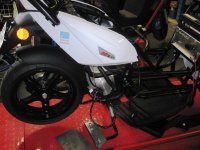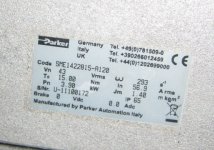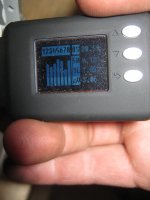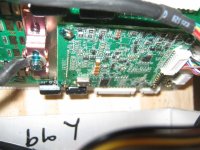You are using an out of date browser. It may not display this or other websites correctly.
You should upgrade or use an alternative browser.
You should upgrade or use an alternative browser.
German Built, Italian design, American engine, Goveck
- Thread starter ProDigit
- Start date
Except that there are no 48V engines...just 48V motors.ProDigit said:New product to me, twice the performance of 48v engines.
(AFAIK: An engine is a motor which converts thermal energy to mechanical energy. A motor is a machine that converts energy to motion. Thus, all engines can be motors, but not all motors are engines. I could be mistaken, of course.)
Translation link:
http://translate.google.com/translate?hl=en&sl=auto&tl=en&u=http%3A%2F%2Fwww.rrmobility.nl%2Fmodelreeks-govecs-elektrische-scooters%2Fgo-s34-govecs-motorscooter-modelgegevens-en-prijs%2F41
I don't know anything about the specs of similar 48V scooters to compare, though.
Thank you for clarifying. In my mother thongue there is no distinction.amberwolf said:Except that there are no 48V engines...just 48V motors.ProDigit said:New product to me, twice the performance of 48v engines.
(AFAIK: An engine is a motor which converts thermal energy to mechanical energy. A motor is a machine that converts energy to motion. Thus, all engines can be motors, but not all motors are engines. I could be mistaken, of course.)
Translation link:
http://translate.google.com/translate?hl=en&sl=auto&tl=en&u=http%3A%2F%2Fwww.rrmobility.nl%2Fmodelreeks-govecs-elektrische-scooters%2Fgo-s34-govecs-motorscooter-modelgegevens-en-prijs%2F41
I don't know anything about the specs of similar 48V scooters to compare, though.
Anyway,
A small correction on what I wrote above, in the translation of the website, the company merely says that 96V engines are more efficient. I got confused because their range measurements are in km instead of miles.
Their range is about as good as the modern bikes, although I believe their claim about 96V being more efficient.
96V means you could charge the battery with a minimum on charger equipment (just an AC-DC converter from 110VAC to 96V DC). It would making a charger for such batteries extremely cheap and lightweight. (I've read an article of a guy just using a graetz bridge (diode bridge), and capacitor, to fast charge his batteries on 110V. That's less than $15-25 on material.
And also interesting to be able to plug in a power cord straight into the bike, without the need for a separate charger, or worrying about Ah rating of extension batteries. Technically the net has enough power to charge 110V upto 15A, and some go even upto 20 or 25A.
Normally a battery 96V, 10Ah, is about as powerful as a 48V, 20Ah.
On their specific equipment, it may well be. But actual efficiency would depend on many factors, including the speed at which it is used and the design of the vehicle.ProDigit said:Their range is about as good as the modern bikes, although I believe their claim about 96V being more efficient.
There are several threads on "bad boy" chargers here on ES, some of which were successful, and some of which weren't finished or tried, or failed.It would making a charger for such batteries extremely cheap and lightweight. (I've read an article of a guy just using a graetz bridge (diode bridge), and capacitor, to fast charge his batteries on 110V. That's less than $15-25 on material.
Not "as powerful" but rather "has the same capacity as". Whether it is as powerful or not depends on the cell types and interconnects, as well as the BMS if any.Normally a battery 96V, 10Ah, is about as powerful as a 48V, 20Ah.
If only it was that clear cut....amberwolf said:(AFAIK: An engine is a motor which converts thermal energy to mechanical energy. A motor is a machine that converts energy to motion. Thus, all engines can be motors, but not all motors are engines. I could be mistaken, of course.)
http://www.worldwidewords.org/articles/engine.htm
jonescg
100 MW
I had the pleasure of working on one of these today.


A local scooter firm imported 8 of them and they all seem to have the same problem - takes a charge, won't let you ride. You can fire things up and gently turn the wheel while it's charging, but if you go too hard it cuts out. I've had this happen before on a 1500 W e-max sport and it turned out the BMS was shagged. Anyway...
I checked the battery voltage with it turned off and not charging, and got about 40 V - it should be over 72 V! However, I plugged the charger in and measured 84V. Hmm. So then I held the multimeter on the pack negative (which is grounded to the chassis! ) and the positive while charging, and pulled the plug on the charger. The voltage dropped rapidly down to 35 V or so.
) and the positive while charging, and pulled the plug on the charger. The voltage dropped rapidly down to 35 V or so.
Figuring this could be charger capacitance I disconnected the battery leads completely and checked the voltage - 72 V and dropping, rapidly. Doesn't look good.
So I ponied up and dismantled the bike so I could finally reef the battery out. Man this is one solid piece of kit! I originally tried to pull it out from the top but it needed about 2 mm clearance. After several lumps of wood and some tyre levers weren't helping, I eventually conceded defeat and had to disconnect all of the cables and take the whole Sevcon controller out. Then the battery slid out through the gap at the back. I took the pack ends apart and this is what I found:
View attachment 1
Samsung 18650 cells in what look to be a 20s22p arrangement. Makes for a 40 Ah pack at 72 V. Bit heavy for under 3 kWh I thought...
Anyway, I checked the voltage at the cell tabs and it was spot on 84 V. Fully charged, waiting to go.

So it looks like the BMS isn't configured properly or something else is up somewhere between the last cell terminal and the controller. Anyone have any ideas?
Chris


A local scooter firm imported 8 of them and they all seem to have the same problem - takes a charge, won't let you ride. You can fire things up and gently turn the wheel while it's charging, but if you go too hard it cuts out. I've had this happen before on a 1500 W e-max sport and it turned out the BMS was shagged. Anyway...
I checked the battery voltage with it turned off and not charging, and got about 40 V - it should be over 72 V! However, I plugged the charger in and measured 84V. Hmm. So then I held the multimeter on the pack negative (which is grounded to the chassis!
Figuring this could be charger capacitance I disconnected the battery leads completely and checked the voltage - 72 V and dropping, rapidly. Doesn't look good.
So I ponied up and dismantled the bike so I could finally reef the battery out. Man this is one solid piece of kit! I originally tried to pull it out from the top but it needed about 2 mm clearance. After several lumps of wood and some tyre levers weren't helping, I eventually conceded defeat and had to disconnect all of the cables and take the whole Sevcon controller out. Then the battery slid out through the gap at the back. I took the pack ends apart and this is what I found:
View attachment 1
Samsung 18650 cells in what look to be a 20s22p arrangement. Makes for a 40 Ah pack at 72 V. Bit heavy for under 3 kWh I thought...
Anyway, I checked the voltage at the cell tabs and it was spot on 84 V. Fully charged, waiting to go.

So it looks like the BMS isn't configured properly or something else is up somewhere between the last cell terminal and the controller. Anyone have any ideas?
Chris
agniusm
1 MW
I had my scooter behaving like this, it was a fuse. I thought it was a controller blown but simple as that, blown fuse. Dont know why the wheel was spinning slowly off the ground with fuse melted, perhaps arcing, but in 36V system little possible i thought.You can fire things up and gently turn the wheel while it's charging, but if you go too hard it cuts out.
Hillhater
100 TW
Miles said:If only it was that clear cut....amberwolf said:(AFAIK: An engine is a motor which converts thermal energy to mechanical energy. A motor is a machine that converts energy to motion. Thus, all engines can be motors, but not all motors are engines. I could be mistaken, of course.)
http://www.worldwidewords.org/articles/engine.htm
And they didnt even include the East London version .." Mowtah" ( pronounced with a silent t ) ... meaning "Jam Jar" ..
...Err ?.. or CAR. :lol:
jonescg
100 MW
Well I checked the fuses and they're all still in good shape. The battery leads after the BMS give 84 V, decaying rapidly to about 35 V before I got tired of holding the meter there. So that was clearly a small cap draining. The main cell terminals give a steady 84 V, so I conclude that the BMS is at fault / needs to be configured.
Can't wait to take one of these for a spin!
Can't wait to take one of these for a spin!
dnmun
1 PW
are you gonna try to diagnose the BMs or just throw it away?
jonescg
100 MW
Oh we'll try to diagnose the problem first. If all 8 have the same problem it's most likely a settings thing.
John in CR
100 TW
Did you check the voltage on each 1s? Maybe it has a low group and the BMS is correctly shutting down.
jonescg
100 MW
Good suggestion - I'll take a Cell-Log 8 up to the shop next time.
However, given all 8 scooters are showing the same problem I'm wondering if there's a factory setting which hasn't been applied to them.
However, given all 8 scooters are showing the same problem I'm wondering if there's a factory setting which hasn't been applied to them.
dnmun
1 PW
we did not see the layout but if you look for a switch which is in the circuit providing current from the SMPS section. it may be shut off for shipping at the factory and you have to turn on the power to the BMS to activate it. it has those two separate thermistor inputs on the side too. i would look for Vcc from the power supply section first. then check to see if there is gate voltage.
jonescg
100 MW
Just checked the individual cell voltages today - they were all over the shop. Some are at 1.1 volts, others at 4.4 V volts. Another e-scooter dealer was at EV-Shop today to drop some things off and he instantly recognised the Govecs scooter.
"Oh those were the ones from Causeway Yamaha"
"Yes, that's them. Do you know much about them?"
"Yes, they ordered a dozen of then three years ago. Dumb shits don't know how to sell electric scooters, so they left them uncharged for three years."
 Yep, that's why the BMS needs to be disconnected in storage... Hope to fix it with my trusty BC168.
Yep, that's why the BMS needs to be disconnected in storage... Hope to fix it with my trusty BC168.
"Oh those were the ones from Causeway Yamaha"
"Yes, that's them. Do you know much about them?"
"Yes, they ordered a dozen of then three years ago. Dumb shits don't know how to sell electric scooters, so they left them uncharged for three years."
John in CR
100 TW
Damn BatteryMurderingSystems strike again. It would be nice sometime to hear how a battery was saved by a BMS. I'd like to believe that by now someone has come up with a cheap BMS that does less harm than good.
dnmun
1 PW
did you figure out how it works yet? i saw the two caps on the top layer in the picture you took from the side so i figured the SMPS is coming off the top of the battery since it is on the side away from the output circuits. but you would expect all the cells to be drained the same amount if it took power from the top of the pack.
jonescg
100 MW
No idea how the BMS is supposed to work, but I do know the cells are way out. There are high cells and low cells and it is doing it's job by preventing me from riding. Couple of images attached for your interest.


Klaus Rheinschmitt, formerly a technician at Vmoto said that all of their lithium E-max 110s scooters had failed batteries due to the BMS. His experience was a 100% failure rate, and always because the BMS drained the battery flat after sitting in showrooms for too long. He wasn't particularly impressed with their use of the cylindrical cells, especially since there are like 22 of them in parallel.
Anyway, I am slowly bringing the cells back into balance. We'll see how long they last, but it should get the scooter going again. For how long, who knows.


Klaus Rheinschmitt, formerly a technician at Vmoto said that all of their lithium E-max 110s scooters had failed batteries due to the BMS. His experience was a 100% failure rate, and always because the BMS drained the battery flat after sitting in showrooms for too long. He wasn't particularly impressed with their use of the cylindrical cells, especially since there are like 22 of them in parallel.
Anyway, I am slowly bringing the cells back into balance. We'll see how long they last, but it should get the scooter going again. For how long, who knows.
Hillhater
100 TW
So he is obviously not a battery specialist then ?jonescg said:Klaus Rheinschmitt............
........ He wasn't particularly impressed with their use of the cylindrical cells, especially since there are like 22 of them in parallel..
Maybe he should have a chat with a certain Mr Musk ? ...he might learn something !
jonescg
100 MW
Mr Musk gives each paralleled cell a fuse and monitoring circuit. Mr Wang just solders them together from the large pile in front of him.
I think the pack would have been fine had the BMS not drained it flat. We're slowly bringing the pack up to full voltage with the balance charger, and I can do a range test tomorrow.
I think the pack would have been fine had the BMS not drained it flat. We're slowly bringing the pack up to full voltage with the balance charger, and I can do a range test tomorrow.
jonescg
100 MW
I should add that the owner of Causeway Yamaha called and we had a chat about the scooters.
He would rather have nothing to do with electric scooters for the rest of his days

See what a poorly designed bit of kit can do? I mean he was adamant that they were charged on a regular basis, but the BMS has clearly let them drift way off balance. At the very least provide some balance taps, rather than seal them inside a "Void if Removed" battery box
He would rather have nothing to do with electric scooters for the rest of his days
See what a poorly designed bit of kit can do? I mean he was adamant that they were charged on a regular basis, but the BMS has clearly let them drift way off balance. At the very least provide some balance taps, rather than seal them inside a "Void if Removed" battery box
dnmun
1 PW
if you can post up a picture of the pcb from both sides we can figure out how the BMS works and show you where to add a switch to turn off the circuit current so the BMS doesn't drain down the cells while sitting unused for years. the big electrolytic caps can only be there if they have some type of SMPS to deliver the circuit current from the 84V off the top of the pack.
they may have left the controller switch on accidentally too while it was on the showroom floor.
they may have left the controller switch on accidentally too while it was on the showroom floor.
Hillhater
100 TW
Fuse ,..yes.jonescg said:Mr Musk gives each paralleled cell a fuse and monitoring circuit. .
Monitoring each cell in a multi cell parallel string ..?? that would be neat, but i dont believe even the amazing Mr Musk could do that !
A 6800 channel BMS ?? that would be a nightmare !
but most of the "high end" 18650 cells can be had with a thermal fuse, and over charge/discharge protection inbuilt .
jonescg
100 MW
Well I balance charged each cell back to 4.2 V and put the battery back together. Plugged it in and tried to fire it up.
Nothing.
I plugged the charger in and fired it up, and it starts.
So I took the main fuse out of the battery + lead and repeated, indicating the battery is not providing power to the bike, including the DCDC converter. The fuse to the DCDC is still in working order, so I might just pull the front off and see that there aren't any loose connections on the converter. After all, if the BMS needs 12 V to function properly and it's not getting it, that could explain the situation.
Sigh.
Nothing.
I plugged the charger in and fired it up, and it starts.
So I took the main fuse out of the battery + lead and repeated, indicating the battery is not providing power to the bike, including the DCDC converter. The fuse to the DCDC is still in working order, so I might just pull the front off and see that there aren't any loose connections on the converter. After all, if the BMS needs 12 V to function properly and it's not getting it, that could explain the situation.
Sigh.

